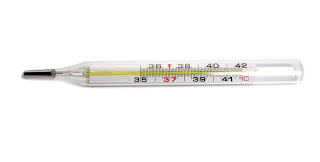Liquid in Glass Thermometer

- Liquid in glass thermometer works on the principle that liquid expands as the temperature increases and contracts as the temperature decreases.
- The most commonly used liquids in such thermometers are
- Mercury
- Alcohol
Q & A
Q: State the advantageous and disadvantageous of using mercury as the liquid in a liquid in glass thermometer.A:
Advantageous:
- Doesn’t wet the wall of the capillary tube.
- Can be seen easily
- Expand uniformly when heated
- Good heat conductor
Disadvantageous:
- Freezing point = -39°C. Not suitable to measure temperature lower than -39°C.
- Poisonous
- Expensive
Q & A
Q: State the advantageous and disadvantageous of using alcohol as the liquid in a liquid in glass thermometer.A:
Advantageous:
- Freezing point = -115°C. Suitable for measuring low temperature.
- Expands greater than mercury.
Disadvantageous:
- Transparent. Difficult to be seen. Need to be coloured.
- Always cling the wall of the capillary tube.
- Has tendency to break the tube at high temperature.
Q & A
Q: State the characteristics of the liquid used in a liquid in glass thermometer.A:
- Easily visible
- Good conductor of heat
- Expand and contract rapidly over a wide range of temperature
- Does not cling to the wall of the capillary tube of the thermometer.
Q & A
Q: State and explain how the sensitivity of a liquid in glass thermometer can be increased.A:
- The sensitivity of a mercury thermometer can be increased by using a smaller mercury bulb, thinner wall and smaller bore.
- A smaller bulb contains less mercury and hence absorbs heat in shorter time. As a result it can response faster to temperature change.
- A glass bulb with thinner wall can transfer heat to the bulb easier. Therefore, the thermometer can response quickly to small changes of temperature near the surrounding.
- Capillary with narrow bore produces a greater change in the length of the mercury column. Therefore a small change in temperature can be detected easily.